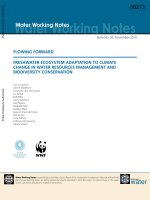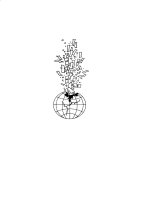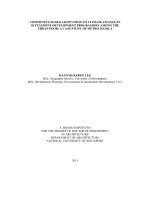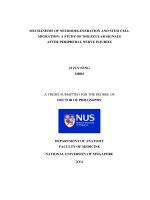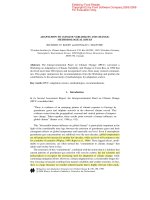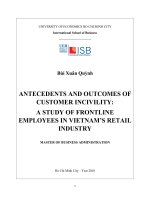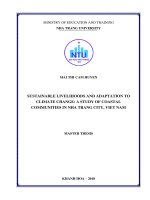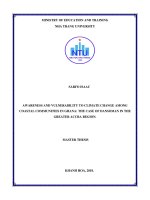Sustainable livelihoods and adaptation to climate change a study of coastal communities in nha trang city, viet nam
Bạn đang xem bản rút gọn của tài liệu. Xem và tải ngay bản đầy đủ của tài liệu tại đây (2.52 MB, 101 trang )
MINISTRY OF EDUCATION AND TRAINING
NHA TRANG UNIVERSITY
MAI THI CAM HUYEN
SUSTAINABLE LIVELIHOODS AND ADAPTATION TO
CLIMATE CHANGE: A STUDY OF COASTAL
COMMUNITIES IN NHA TRANG CITY, VIET NAM
MASTER THESIS
KHANH HOA – 2018
MINISTRY OF EDUCATION AND TRAINING
NHA TRANG UNIVERSITY
MAI THI CAM HUYEN
SUSTAINABLE LIVELIHOODS AND ADAPTATION TO
CLIMATE CHANGE: A STUDY OF COASTAL
COMMUNITIES IN NHA TRANG CITY, VIET NAM
MASTER THESIS
Major:
Marine Ecosystem Management and
Climate Change
Code:
1006/QĐ-ĐHNT dated 10/10/2017
Topic allocation Decision
Decision on establishing the Committee:
Defense date:
Supervisors:
1: PROF. PETER ARBO
2: PROF. NGUYEN THI KIM ANH
Chairman of Committee:
Dr. LE KIM LONG
Faculty of Graduate Studies:
KHANH HOA – 2018
UNDERTAKING
I undertake that the thesis entitled: “Sustainable livelihoods and adaptation to
climate change: a study of coastal communities in Nha Trang City, Viet Nam” is my
own work. The work has not been presented elsewhere for assessment until the time
this thesis is submitted.
Khanh Hoa, June 25, 2018
Author
Mai Thi Cam Huyen
iii
ACKNOWLEDGMENT
I would like to express the appreciation to the Graduate Study Faculty of Nha
Trang University for helping and giving me best conditions to finish my thesis.
My special thanks to Prof. Peter Arbo and Dr. Pham Thi Thanh Thuy for the
continuous support of my Master study and research, for their patience, enthusiasm,
and immense knowledge. Their guidance helped me in all the time of research and
writing of this thesis.
I also would like to acknowledge and thank to Norhed program, University of
Nha Trang and Tromso as well as Prof. Nguyen Thi Kim Anh for giving me the
opportunity to study Marine Ecosystem Management and Climate Change.
Last but not the least, I would like to thank the leaders of POU university
where I am working for giving the chance, time as well as motivation to finish my
master course and my family, friends for supporting me spiritually throughout writing
this thesis.
Thank you!
Khanh Hoa, June 25, 2018
Author
Mai Thi Cam Huyen
iv
TABLE OF CONTENTS
UNDERTAKING .......................................................................................................... iii
TABLE OF CONTENTS ................................................................................................ v
LIST OFABBREVIATIONS ...................................................................................... viii
LIST OF TABLES .........................................................................................................ix
ABSTRACT ................................................................................................................. xii
CHAPTER 1: INTRODUCTION...................................................................................1
1.1. Introduction ..............................................................................................................1
1.2. Thesis objectives and research questions .................................................................2
1.2.1. Thesis objective .....................................................................................................2
1.2.1.1. General objective ................................................................................................ 2
1.2.1.2. Specific objectives .............................................................................................. 3
1.2.2. Research questions ................................................................................................ 3
1.3. Subject and scope of study .......................................................................................3
1.3.1. Research subject ....................................................................................................3
1.3.2. Scope of the study .................................................................................................4
1.4. Structure of the thesis ............................................................................................... 5
CHAPTER 2: OVERVIEW OF CLIMATE CHANGE AND SUSTAINABLE
LIVELIHOODS...............................................................................................................6
2.1. Climate change .........................................................................................................6
2.1.1. Concepts related to climate change .......................................................................6
2.1.2. The situation of climate change in the world ........................................................7
2.1.3. The situation of climate change in Viet Nam ........................................................7
2.2. Sustainable livelihoods ............................................................................................. 9
2.2.1. Sustainable livelihoods framework .....................................................................10
2.2.2. Typical sustainable livelihoods frameworks .......................................................12
2.3. Sustainable livelihoods and climate change ........................................................... 15
2.3.1. Sustainable livelihood framework and climate change .......................................15
2.3.2. Impacts of climate change to coastal livelihoods ................................................16
2.3.3. Adaptability of coastal livelihoods to the impacts of climate change .................17
v
2.3.4. Support livelihoods to adapt to climate change...................................................19
CHAPTER 3: METHODS OF DATA COLLECTION AND PROCESSING ............20
3.1. Method of data collection .......................................................................................20
3.1.1. Primary data ........................................................................................................20
3.1.1.1. Focus group discussion.....................................................................................20
3.1.1.2. Household survey ............................................................................................. 21
3.1.2. Secondary data .....................................................................................................21
3.2. Data processing methods ........................................................................................ 22
3.3. Sample ....................................................................................................................24
CHAPTER 4: BACKGROUND INFORMATION OF THE STUDY AREA .............25
4.1. Khanh Hoa province ............................................................................................... 25
4.1.1 Geographical features ........................................................................................... 25
4.1.2. Climate.................................................................................................................25
4.1.3. Population characteristics ....................................................................................26
4.1.4. Current status of coastal household livelihoods in Khanh Hoa province ...........26
4.2. Current status of coastal household livelihoods in the two study areas .................30
4.2.1. Vinh Luong ward .................................................................................................30
4.2.1.1. Geographic location.......................................................................................... 30
4.2.1.2. Livelihood resources ........................................................................................ 31
4.2.1.3. Livelihood activities ......................................................................................... 33
4.2.1.4. Livelihood outcome .......................................................................................... 34
4.2.1.5. The status of basic social services ....................................................................35
4.2.2. Vinh Nguyen ward .............................................................................................. 35
4.2.2.1. Geographic location.......................................................................................... 35
4.2.2.2. Livelihood resource .......................................................................................... 36
4.2.2.3. Livelihood activities ......................................................................................... 38
4.2.2.4. Livelihood outcome .......................................................................................... 39
4.2.2.5. The status of basic social services ....................................................................40
CHAPTER 5: CLIMATE CHANGE AND ADAPTATION TO CLIMATE CHANGE
IMPACTS ......................................................................................................................42
5.1. Climate change on coastal households in Nha Trang city.....................................42
5.1.1. Temperature .........................................................................................................42
vi
5.1.2. Rainfall ................................................................................................................43
5.1.3. Floods ..................................................................................................................45
5.1.4. Drought ................................................................................................................46
5.1.5. Salinity intrusion .................................................................................................46
5.1.6. Sea rise level ........................................................................................................46
5.1.7. Other types of natural disasters ...........................................................................47
5.1.8. Possible impacts of climate change to coastal households in Khanh Hoa
province ......................................................................................................................... 47
5.2. Climate change and climate change impacts in the two study areas ......................49
5.2.1. Affected household livelihood resources ............................................................ 50
5.2.2. Affected livelihood activities ..............................................................................51
5.2.3. Affected livelihood outcomes..............................................................................53
5.3. Analyzing adaptive capacity of coastal household livelihoods to the impacts of
climate change ...............................................................................................................54
5.3.1. Livelihoods of aquaculture ..................................................................................54
5.3.2. Livelihoods of capture fisheries ..........................................................................55
5.4. Adaptation measure to the impacts of climate change ...........................................56
5.4.1. Adaptation activities in fishing ............................................................................56
5.4.2. Adaptation activities in aquaculture ....................................................................58
5.4.3. Demand for the forms of State support .............................................................. 59
5.4.4. Discussion on household-level and community-level adaptation activities to the
current climate change ...................................................................................................61
5.4.4.1. Aquaculture Group ........................................................................................... 61
5.4.4.2. Fishing Group ...................................................................................................62
5.4.4.3. Discussion on local and state support and some sustainable livelihoods in the
context of climate change .............................................................................................. 62
CHAPTER
6:
SOME
POLICY
RECOMMENDATIONS
TO
SUPPORT
LIVELIHOODS IN ADAPTATION TO CLIMATE CHANGE FOR COASTAL
COMMUNITIES IN NHA TRANG CITY, KHANH HOA PROVINCE ....................65
CHAPTER 7: CONCLUSION ......................................................................................68
REFERENCE ................................................................................................................71
APPENDIX: QUESTIONAIRE ....................................................................................75
vii
LIST OFABBREVIATIONS
UNDP
: United Nations Development Programme
MONRE
: Ministry of Natural Resources and Environment
DFID
: Department for International Development
IPCC
: Intergovernmental Panel on Climate Change
MARD
: Ministry of Agriculture and Rural Development
ADB
: Asian Development Bank
IMM
: Integrated Marine Management
SLF
: Sustainable livelihoods framework
CARE
: Cooperative for Assistance and Relief Everywhere
DANIDA
: Danish International Development Agency
IMOLA
: Integrated Management of Lagoon Activities
CV
: Cheval Vapeur in French equal to Horse Power in English
viii
LIST OF TABLES
Table 2.1: Impacts of climate change coastal livelihoods .............................................17
Table 2.2: Some measures to adapt to climate change by sector .................................18
Table 3.1: The analytical framework.............................................................................20
Table 4.1: Average temperature and rainfall in Khanh Hoa province .......................... 25
Table 4.2: Agricultural land area ...................................................................................27
Table 4.3: Number of employees working in Khanh Hoa province ............................. 28
Table 4.4: Access to information in Nha Trang city .....................................................28
Table 4.5: Numbers of laborers by livelihood activity ..................................................29
Table 4.6: Average income per capita/a month in Khanh Hoa province ......................29
Table 4.7: Unemployment rate in Khanh Hoa .............................................................. 30
Table 4.8: The poverty rate ........................................................................................... 30
Table 4.9: Socio-demographic characteristics of household members surveyed in Vinh
Luong commune ............................................................................................................32
Table 4.10.: Assessment of respondents on income changes over the past five years in
Vinh Luong commune ...................................................................................................34
Table 4.11: Socio-demographic characteristics of household members surveyed in
Vinh Nguyen ward.........................................................................................................37
Table 4.12. Number of fishing boats, aquaculture rafts and catch and aquaculture
output ............................................................................................................................. 39
Table 4.13.: Assessment of respondents on income changes over the past five years in
Vinh Nguyen ward.........................................................................................................39
Table 5.1: Annual average temperature in Nha Trang (1978 - 2015) ........................... 42
Table 5.2: Average annual rainfall of the areas in each period .....................................43
Table 5.3: Rainfall in 2020 under the average emission scenario (B2) ........................ 44
Table 5.4: Tropical cyclones and storms hit Khanh Hoa and neighboring provinces ..44
Table 5.6: The impact of climate change on people's lives in two coastal areas, Nha
Trang city.......................................................................................................................49
Table 5.7: Household livelihood resources affected by storms and floods in two coastal
areas, Nha Trang city .....................................................................................................50
ix
Table 5.8: Livelihoods activities affected by storms and floods in two coastal
communities, Nha Trang province ................................................................................51
Table 5.9: Results of livelihood outcome affected by floods and storms in two coastal
communities, Nha Trang city ........................................................................................ 54
Table 5.10: Adaptation in capture fisheries ...................................................................57
Table 5.11: Adaptation in aquaculture ..........................................................................58
Table 5.12: Demand for the Forms of State Support ....................................................60
x
LIST OF FIGURES
Figure 1.1: The map of Nha Trang city ...........................................................................4
Figure 2.1: Sustainable rural livelihoods framework (Source: Scoones, 1998) ............13
Figure 2.2: Sustainable livelihoods frame ....................................................................14
Figure 2.3: Sustainable coastal livelihoods framework.................................................14
Figure 5.1: Annual average temperature in Nha Trang (1978 - 2015) .......................... 42
xi
ABSTRACT
Climate change has become a great concern in the world in general and Viet Nam
in particular. Floods and storms has had bad impacts on coastal household livelihoods,
especially aquaculture and fishing activities, which depend on resources adversely
impacted by extreme variations. Therefore, adaptive activities play a key role in
minimizing effects of climate change, enhancing resistance to climate change and
creating sustainable livelihoods. This thesis investigates current and possible risks of
climate change on coastal households and adaptation capacity of coastal livelihoods to
the impacts of climate change at household level in two representative coastal areas in
Nha Trang city. The study is based on a survey, interviews and discussions among
households in Vinh Nguyen ward and Vinh Luong commune, Nha Trang City. The
findings of the survey show that floods and storms has had severe impacts on local
aquaculture and fishing households. Another finding is that fishing and aquaculture
households have used passive measures to adapt to the impacts of these extreme
weather events. Finally, the results show that state and relevant agencies have provided
institutional and policy supports to local households to help them in coping with the
effects of extreme variations.
Key words: Floods and storms, coastal fishing and aquaculture households,
livelihood, risks, adaptation.
xii
CHAPTER 1: INTRODUCTION
1.1. Introduction
Climate change, especially global warming and sea level rise, is one of the
largest challenges to mankind in the twenty-first century and a threat to the sustainable
development of all countries in the world, especially to the developing countries
(Nhung, 2016). “The Earth’s climate has been changing already and failure to
limit warming to below 2°C could make the changes in the climate system
irreversible and characterized by cataclysmic consequences. The adverse
impacts such as drought, sea level rise and more erratic storms continue to
overly burden the poorest and the most vulnerable, especially poor women and
bring risks to their livelihoods and lives” (UNDP, 2017).
Viet Nam's territory runs along the east coast of the Indochinese peninsula,
Southeast Asia. According to UNDP (2010), Viet Nam is one of the five leading
countries in the world most vulnerable to climate change and is frequently exposed to
natural disasters. So Viet Nam is seriously affected by climate extremes and climate
variability. In the last 50 years, the average temperature has increased by 2-3°C and
the sea level has increased by about 20cm. It is predicted that by the end of the 21st
century, according to the high emission scenarios, the average temperature in Viet
Nam could increase by 2.5 - 3.7°C and the sea level could rise by 78-95cm (MONRE,
2012). If the Earth's temperature rises by 2°C, about 22 million Vietnamese will lose
their homes and 45% of agricultural land in the Mekong Delta will be submerged in
seawater (Chaudhry and Ruysschaert, 2007).
Khanh Hoa is a province in the South Central Coast of Viet Nam with a long
coast along the water's edge and many canals, lagoons, bays, about 200 large and small
islands and many beautiful beaches (). The main
livelihoods in the coastal communities of the Khanh Hoa province are agricultural
production (cultivation, husbandry, salt making) and fisheries (capture and
aquaculture). These livelihoods are increasingly threatened by climate change. For
recent years, the rainfall in Khanh Hoa has been erratic and fluctuating and the
temperature has become higher and higher. The frequency and magnitude of strong
storms and floods have increased sharply in number causing serious socio-economic
1
damage, destroying the natural environment and threatening the lives of people. From
1999 to 2009, 83 people died and economic losses were about 450 billion VND
(Steering Committee for Storm and Flood Control, 2010). Therefore, to determine the
impacts of climate change on coastal livelihoods and to build sustainable livelihoods
adapting to climate change is an urgent need nowadays in the context of increasingly
abnormal climate in coastal areas in general and coastal areas in Khanh Hoa province
in particular.
According to the 2014 Vietnamese report on the average emission scenario
(scenario B2) in 2050, the annual average temperature will increase by 2 to 3°C, the
rainfall by 2-7%, the sea level by 57-73cm and 20,829 km2 will be flooded. In
scenario A1F1, the flooded area will be about 21,109 km2. Water resources will
become scarce due to salinity intrusion and drought. The changing habitat conditions
will change the distribution of organisms and reduce yields. The quality of seafood
products will also be difficult to achieve as it is today. The climate change impacts will
increase the cost of new construction and repair of infrastructure and affect people's
livelihoods (Department of Natural Resources and Environment of Khanh Hoa
Province, 2014).
This research project is implemented to determine the livelihood status of coastal
households in Vinh Nguyen ward and Vinh Luong commune, Nha Trang city, to
identify the current and possible future impacts of climate change on coastal
households and to assess adaptive capacity and relevant actions for different livelihood
groups of coastal households in these two study areas. Based on the research results,
the author will help the local leaders and managers identify strategies and measures
that can secure sustainable livelihoods based on local capacity and overall government
policy in Nha Trang City and in Khanh Hoa Province.
1.2. Thesis objectives and research questions
1.2.1. Thesis objective
1.2.1.1. General objective
Based on the sustainable livelihoods framework (SLF) applied to households in
the context of climate change impacts, the research aims to support Khanh Hoa
2
province to understand and know better the risks associated with climate change,
propose sustainable livelihoods adaption to climate change based on local capacity and
policy orientation of the State.
1.2.1.2. Specific objectives
Based on the case study in Vinh Nguyen ward and Vinh Luong commune of Nha
Trang city, Khanh Hoa province the specific research objectives include:
- To determine the livelihood status of coastal households in Nha Trang city,
Khanh Hoa province.
- To identify the current and possible future impacts of climate change on coastal
households in Nha Trang city, Khanh Hoa province.
- To assess adaptive capacity and relevant actions for different livelihood groups
of coastal households in Nha Trang city, Khanh Hoa province.
1.2.2. Research questions
In order to achieve the objectives, this study answer the following research
questions:
- What kind of livelihood resources are used by coastal households to implement
livelihood activities and achieve livelihood outcomes?
- What current and possible future impacts does climate change have on coastal
households in Vinh Nguyen Ward and Vinh Luong commune?
- How do coastal households in Vinh Nguyen ward and Vinh Luong commune
adapt their livelihoods in the face of climate change?
- What support policies should the government select to help households adapt to
climate change?
1.3. Subject and scope of study
1.3.1. Research subject
This study deals with the impact of climate change on the livelihoods of the
coastal households, including issues related to livelihood resources, livelihood
3
activities, livelihood outcomes, risks and adaptability to the impact of climate change
and forms of livelihood support.
1.3.2. Scope of the study
Vinh Nguyen ward and Vinh Luong commune of Nha Trang city are chosen as
research cases of the master thesis because the main livelihoods of these two study
areas are vulnerable due to climate change.
Figure 1.1: The map of Nha Trang city
(Source: />The author conducted a number of household surveys in Vinh Nguyen ward and
Vinh Luong commune of Nha Trang city, Khanh Hoa province. The household
surveys were conducted in 2017 and the effects of climate change on coastal
households were assessed for the five years from 2013 to 2017.
4
1.4. Structure of the thesis
Apart from the opening, the thesis is divided into seven chapters:
Chapter 1: Introduction
Chapter 2: Overview of climate change and sustainable livelihoods
Chapter 3: Methods of data collection and processing
Chapter 4: Background information of the study area
Chapter 5: Climate change and adaptation to climate change impacts
Chapter 6: Some policy recommendations to support livelihoods in adaptation to
climate change for coastal communities in Nha Trang city, Khanh Hoa province
Chapter 7: Conclusion
5
CHAPTER 2: OVERVIEW OF CLIMATE CHANGE AND SUSTAINABLE
LIVELIHOODS
2.1. Climate change
2.1.1. Concepts related to climate change
According to the Intergovernmental Panel on Climate Change (IPCC), in a
narrow sense Climate is usually defined as “the average weather, or more rigorously,
as the statistical description in terms of the mean and variability of relevant quantities
over a period of time ranging from months to thousands or millions of years. The
relevant quantities are most often surface variables such as temperature, precipitation
and wind”. In a wider sense “Climate is the state, including a statistical description, of
the climate system” (IPCC, 2014).
Climate change is considered as “a change in the state of the climate that can be
identified by changes in the mean and/or the variability of its properties and that
persists for an extended period, typically decades or longer” (IPCC, 2014).
Adaptation is regarded as “the process of adjustment to actual or expected
climate and its effects. In human systems, adaptation seeks to moderate or avoid harm
or exploit beneficial opportunities. In some natural systems, human intervention may
facilitate adjustment to expected climate and its effects.” The adaptations can be
anticipatory or reactive adaptation, and they can be private or public (IPCC, 2014).
Adaptive capacity is “the ability of systems, institutions, humans and other
organisms to adjust to to climate change (including climate variability and extremes)
to moderate potential damage, to take advantage of opportunities, or to respond to
consequences” (IPCC, 2014).
All scenarios are based on different assumptions regarding demographic change,
social and economic development and broad technological shifts corresponding to the
four families (A1, A2, B1, B2), each with an illustrative “marker” scenario. Two of the
scenario groups of the A1 family (A1FI, A1T) explicitly explore alternative energy
technology developments, holding the other driving forces constant, each with an
illustrative scenario (IPCC, 2000).
6
2.1.2. The situation of climate change in the world
According to the Intergovernmental Panel on Climate Change’s (IPCC) Fifth
Assessment Report, the Earth’s surface has been successively warmer during the last
three decades and warmer than any preceding decade since 1850. The globally averaged
combined land and ocean surface temperature showed a warming of 0.85 [0.65 to 1.06]
°C over the period 1880 to 2012 and the global mean sea level rose by 0.19 [0.17 to
0.21]m over the period 1901 to 2010. The global mean surface temperature change for
the period 2016–2035 will likely be in the range of 0.3°C to 0.7°C and about 70% of the
coastlines worldwide is projected to experience a sea level change within ±20% of the
global mean. Many extreme weather and climate events such as a decrease in cold
temperature extremes, an increase in warm temperature extremes, an increase in extreme
high sea levels and an increase in the number of heavy precipitation events in a number
of regions have happened since 1950 (IPCC, 2014).
As shown by The United Nations Development Programme, many observed
impacts of the changing climate including sea-level rise, flooding, storms, extreme
weather events and droughts are increasing in frequency and intensity. They are
happening more quickly than previously predicted, threatening coastal communities,
critical infrastructure and damaging agriculture, fishing and other livelihoods.
According to a recent report of the UN Secretary-General, the cost of disasters caused
by climate change has reached an average of $250 billion to $300 billion a year, or
nearly $1.5 trillion in worldwide economic damage during 2003–2013 (UNDP, 2017).
2.1.3. The situation of climate change in Viet Nam
With over 3000 km of coastline, every year Viet Nam must frequently face tropical
cyclones and hurricanes. These natural disasters frequently cause flooding in low-lying
areas such as the floods in Hanoi in November 2008, in the delta areas (for example, in
the Mekong Delta in 2000 and 2001) and in the central region. In the high areas, heavy
rains often cause flash floods and landslides, which cause heavy flooding in downstream
areas. In addition to the adverse effects of weather, Viet Nam also suffers from other
long-term hazards such as shore erosion, salinization of river mouths, which greatly
affects agricultural and fishery livelihoods. According to recent estimates, the total
7
losses from natural disasters particularly typhoons, floods and landslides account for
about 1% of Viet Nam's GDP (MONRE, DFID and UNDP, 2010).
In Viet Nam, in the past 50 years, the average temperature has increased by 0.5 0.7 °C and the sea level has risen about 20 cm. The phenomena of El Nino and La
Nina are increasingly powerful. Climate change has made natural disasters, especially
storms, floods and droughts, more severe. Viet Nam is considered as one of the most
severely affected countries by climate change, and the Mekong River Delta is one of
the three deltas in the world most vulnerable to rising sea levels. According to the
climate change scenarios in Viet Nam, by the end of the 21st century, the annual
average temperature in our country will increase by 2 - 3°C, the total annual rainfall
and the rainy season rainfall will increase while the dry season rainfall will decrease.
The sea level may rise by 75 cm to 1 m compared to the period 1980-1999. If the sea
level rises 1 m, about 40% of the Mekong River Delta, 11% of the Red River area and
3% of the area of other coastal provinces will be inundated, and in Ho Chi Minh City
over 20% of the area will be inundated. In total, about 10 - 12% of the Vietnamese
population will be directly affected. The more intense typhoons often occur and the
storm season ends later than before. Cold air waves cause severe cold and tend to last
longer (MONRE, 2012).
The scenarios of climate change and sea level rise for Viet Nam were developed
and published in 2009 under low greenhouse gas emission scenarios (B1), medium
(B2) and high (A2, A1F1). With the existing studies and calculations of climate
models in Viet Nam, the greenhouse gas emission scenarios were selected to update
the climate change scenarios and sea level rise for Viet Nam in the 21st century. The
IPCC’s emission scenarios include B1, A1T (low emission scenarios); B2, A1b
(medium emission scenarios) and A2, A1F1 (high emission scenarios). The base
period to compare climate change in the 21st century is the period 1980-1999 and this
is also the period used by the IPCC in the 2007 Assessment Report. Under the
scenarios, the following climate change is expected in Viet Nam in the coming years:
- According to the low emission scenarios: by the end of the 21st century, the
annual average temperature will rise by 1.6 °C to 2.2°C, the rainfall will increase by 26%, the sea level will rise by 49-64cm.
8
- According to the medium emission scenario: by the end of the 21st century, the
annual average temperature will increase by 2 to 3°C, the rainfall will increase by 2 to
7%, the sea level will rise by 57 to 73cm.
- According to the high emission scenario: by the end of the 21st century, the
annual average temperature will increase by 2.5 to 3.7°C, the rainfall will increase by
2-10%, the sea level will rise by 78-95cm.
Recent research by the Asia Foundation indicates that in the past 20 years, Viet Nam
has been one of the five countries in the world with the highest natural disaster risk, with
estimated losses accounting for 1.5% of annual GDP (the Asia Foundation, 2015).
As evidenced in the recent five years, each year disasters killed about 500 people,
causing damage worth 14,500 billion VND, equivalent to 1.2% of the country’s GDP.
From 2005 to 2014, the annual average in Viet Nam is about 649 natural disasters such
as floods, hails, storms, flash flood, cyclones and landslides. On average in Viet Nam,
469,526 houses were destroyed, and 174,663 houses were damaged due to natural
disasters. Of these total losses, the economic losses caused by flooding accounted for
the largest share, with 58%. The economic damage caused by the typhoons was about
29%, ranking the second (MONRE, 2015).
2.2. Sustainable livelihoods
Sustainable livelihoods have been a major concern for researchers and policy
makers in many countries around the world. The ultimate goal of the development
process for nations is to improve livelihoods and improve social welfare for the
population, and at the same time to secure sustainable development.
According to Chambers and Conway (1992), a livelihood consists of the
capabilities, assets (stores, resources, claims and access) and activities required for a
means of living. The sustainability of livelihoods is assessed in two ways: the
environmental sustainability (referring to the viability of livelihoods in preserving or
enhancing natural resources for future generations) and social sustainability (referring
to livelihoods in dealing with stress and mutation). A livelihood is considered
sustainable when it promotes the potential of human beings to produce and sustain
9
their livelihood. It must be able to cope and overcome the pressure as well as
unexpected changes. It must not be overexploited or detrimental to the environment
and should contribute net benefits to other livelihoods at the local and global levels in
the present and in the future and promote harmony among them and bring good things
to future generations (IMOLA Project, 2006).
Later research by Scoones (1998), DFID (2001) and Solesbury (2003) developed
the sustainability of livelihoods in both economic and institutional terms and came up
with a set of criteria for assessing the sustainability of livelihoods on four dimensions:
economic, social, environmental and institutional.
- Economic sustainability is when it can achieve and maintain a basic level of
economic welfare and this economic welfare may vary across regions.
- Social sustainability is achieved when social discrimination is minimized and
social justice is maximized.
- Environmental sustainability is assessed through more sustainable use of natural
resources (land, water, forests, sea, etc.), not destroying the environment (pollution,
environmental degradation).
- Institutional sustainability is assessed through a number of criteria: support and
legitimacy; participatory policy-making processes, public and private sector agencies
and organizations operate effectively. This creates a favorable institutional and policy
environment to help improve livelihoods over time.
According to the authors, all four aspects are equally important and it is
necessary to find an optimal balance.
2.2.1. Sustainable livelihoods framework
Sustainable livelihood frameworks analyze the interaction of five groups of
factors that affect household livelihoods: (i) livelihood resources; (ii) livelihood
strategies, (iii) livelihood outcomes, (iv) institutional and policy processes, and (v)
external context (DFID, 2001).
Livelihood resources and the human ability to access livelihood resources are
considered to be central elements in the approach to sustainable livelihoods. There are
10
five types of livelihood resources: Natural resources include natural resources that
humans can use to carry out livelihood activities, such as land, forests, marine
resources, water, air, and biodiversity. Physical resources include basic infrastructure
that supports livelihood activities, such as roads, housing, water supply, drainage,
energy, and information. Financial resources include the different sources that human
use to achieve livelihood goals such as savings, cash, jewelry, loans, and income.
Human resources include skills, knowledge, experience, working capacity, health and
education, which help people implement different livelihood strategies and achieve
different livelihood outcomes. At the household level, human resources are the
decisive factor in the quantity and quality of labor, and it varies according to
household size, skill levels, and health. Social resources include the relationships
between people and the society on which they depend to implement livelihoods,
mainly social networks (political or civilian), membership of community
organizations, market access, and so on.
- Livelihood activities are the ways in which the household uses available
livelihood resources to make a living and meet the needs of life. For example, a
fisherfolk who makes a living by catching fish will use livelihood resources such as:
(i) natural resources (fishery resources); (ii) physical resources (fishing boats, fishing
gears, docks); (iii) human resources (labor force, health, knowledge and experience in
fisheries), (iv) social resources (market for products), and (v) financial resources
(loans from banks, relatives, and friends). Different groups of people in the community
having different socio-economic characteristics and different livelihood resources
should select different livelihood strategies. Possible livelihood activities are
agricultural production, capture fisheries, aquaculture, small-scale industrial
production, trade, tourism, or migration.
- Livelihood outcomes are what the households achieve by combining different
livelihood resources to implement livelihood activities. Major livelihood outcomes
include: increased incomes, improved welfare, enhanced food security, more
sustainable use of natural resources. These livelihood outcomes reflect the
sustainability of livelihoods across four dimensions: social, economic, environmental
and institutional.
11
- Institutions (public and private institutions), laws and policies play an important
role in the success of livelihoods. The institutions and policies are developed and
operated at all levels, from the household level to the higher levels such as regional,
national and international levels. These institutions and policies determine the access
to livelihood resources and the implementation of livelihood strategies of individuals,
households and different target groups.
- The external context, simply understood, is the external environment in which
humans live. People’s livelihoods and their livelihood resources are greatly influenced
by three elements of the external context: trends, shocks and seasonality. Trends
include population trends, livelihood resources, national and international economic
activities, national political situation, technological change, etc. Shocks include health
shocks (diseases), natural shocks (weather, natural disasters), economic shock (crisis)
and crop/livestock shock. Seasonality involves changes in prices, production activities,
and seasonal employment opportunities. Besides, there are more threats to local
people’s livelihoods: new development projects, big constructions, removal of people
to make space for tourism and new large-scale businesses as well as pollution.
Of the five components that make up the sustainable livelihoods framework, the
livelihood resources play a key role in livelihood activities at the individual, household
or group level as it determines which livelihood strategies are followed to achieve the
desired livelihood outcomes. However, these livelihood resources are also influenced
by external contextual factors as well as local institutions and policies. Therefore, the
interaction between these factors combined with the need for livelihoods will
determine the livelihood strategies of individuals, households and different target
groups.
2.2.2. Typical sustainable livelihoods frameworks
Sustainable livelihood analysis is basically about learning about people's
livelihoods and then finding ways to make them sustainable.
12
Figure 2.1: Sustainable rural livelihoods framework (Source: Scoones, 1998)
Scoones was the first to provide an analytical framework for sustainable rural
livelihoods. This framework indicated how, in a specific context (environment, policy,
politics, history, ecology, socio-economic conditions), sustainable livelihoods are
achieved through access to a range of livelihood resources (natural, economic, human
and social capitals) which are combined in the pursuit of different livelihood strategies
(agricultural production, livelihood diversification and migration). The main concerns
in this framework are institutional and organizational processes which are considered
as intermediary factors to implement these livelihood strategies and achieve the
desired livelihood outcomes. Among the components making up the sustainable
livelihoods framework, the livelihood resources play a key role in livelihood activities
at all levels.
The Department for International Development (DFID) in the United Kingdom in
2001 launched a sustainable livelihoods framework to identify and design supporting
activities. It is also considered as a comprehensive approach to development issues in
human livelihoods and poverty in different contexts. According to this framework,
households have a livelihood approach (livelihood strategy) based on available
livelihood resources within the local policy and institutional context. The choice of
13
